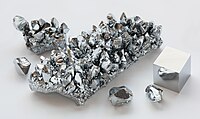
Photo from wikipedia
Abstract Herein, nanocomposite coatings consisting of chitosan (CSNPs) and cobalt nanoparticles (CoNPs) were deposited on bare 316L stainless steel alloy (316L SS) as a bone implant. Scanning electron microscope (SEM)… Click to show full abstract
Abstract Herein, nanocomposite coatings consisting of chitosan (CSNPs) and cobalt nanoparticles (CoNPs) were deposited on bare 316L stainless steel alloy (316L SS) as a bone implant. Scanning electron microscope (SEM) and energy dispersive X-ray (EDX) were applied to characterize the morphological and chemical composition of the tested nanocoatings. In-vitro degradation and hydrogen evolution behaviour of the coated samples were examined by means of electrochemical impedance spectroscopy (EIS) and potentiodynamic polarization techniques, in Hank's solution containing of 1 × 10−3 M calcium hydrogen phosphate drug at pH 7.4 and temperature 37 °C. This drug used as an inhibitor for protecting the alloy surface from the corrosive medium and minimized the hydrogen evolution rate. Results showed that the di-phasic coating (CoNPs-CSNPs) gave the highest electrochemical corrosion resistance with the lowest hydrogen evolution rate in comparison to the monophasic coatings (CS-NPs & Co-NPs). These corrosion results suggested that a CoNPs-CSNPs nanocomposite coating on 316L SS was effective for renewable or functional implants.
Journal Title: International Journal of Hydrogen Energy
Year Published: 2021
Link to full text (if available)
Share on Social Media: Sign Up to like & get
recommendations!